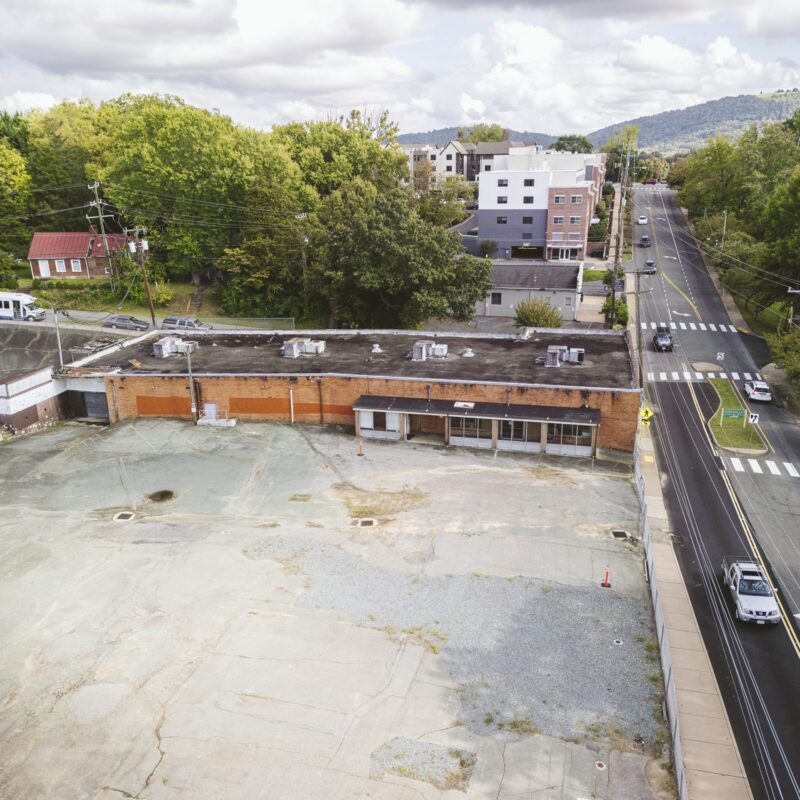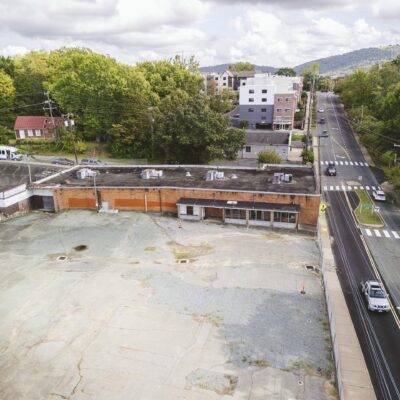Tuesday, January 10
New Mall auto crossing hits roadblock
Today the Charlottesville Planning Com-mission voted against a second auto crossing on the Downtown Mall. Business owners requested a crossing on the east end of the Mall, at Fourth or Fifth streets, arguing that the closure of Sixth and Seventh streets near the Charlottesville Pavilion and Transit Center had hurt business. The Commission said that once the construction on the Transit Center is finished, the City should post signs to help people find the Mall; Commissioners also suggested reversing the flow of traffic at the Second Street crossing on the Mall’s west end. City Council could vote to reject the Commission’s recommendations when they take up the issue later.
Wednesday, January 11
Cops say officer may have beaten drunkard
Today Virginia State Police arrested City police officer Cliff Goodwin, who will appear in court on charges of misdemeanor assault and battery in connection with a drunk-driving arrest. Police launched an investigation last August after Goodwin brought a DUI suspect to the magistrate’s office at the regional jail. Because the incident took place at the magistrate’s office, the matter fell to Albemarle Commonwealth’s Attorney Jim Camblos, who requested an investigation by the Virginia State Police. After their investigation, Camblos sought a warrant for Goodwin’s arrest, which was served today. Goodwin was not detained and was reassigned to administrative duties, where he will remain until after his court date later this month.
More chance to sound off on MCP
Today steering committee members met to work on the Route 250 Bypass Interchange that will connect the Meadowcreek Parkway to the Bypass and McIntire Road. At issue is what kind of interchange, if any, will be constructed at this as-yet unbuilt origin of the oft-debated Parkway. Those of you with an opinion should know that the committee will hold the first of two public workshops in March. See more at 250interchange.org.
Thursday, January 12
Hundreds rally to discuss Crozet growth
Tonight 300 residents attended the Crozet Community Association meeting to discuss a recent population projection that has doubled from the original Crozet Master Plan estimate of 12,000. Albemarle County Board Chairman Dennis Rooker said developments such as Old Trail Village will likely never reach their upper limit even within the projected 16-year build-out due to roads and the natural topography of the land. But activist Ken Loach called the new total of 24,000 an administrative fiat and asked, “How many people would like to see Crozet grow to half the size of Charlottesville?” None there raised their hands.
Friday, January 13
Albemarle First gets another dance partner
Locally owned Albemarle First Bank announced today that it intends to merge with Winchester-based Premier Commun-ity Bankshares, in a deal that is expected to close in the second quarter of this year. In a cash and stock agreement valued at about $29 million, Premier will issue its stock or equivalent cash to Albemarle First shareholders at $15.80 per share. Albemarle First shares closed today at $14.65. This is not the bank’s first spin on the M&A dance floor. Last summer it announced a planned merger with Millennium Bankshares, but Millennium shareholders rejected the deal.
Saturday, January 14
All-American Brooks picks UVA over NFL
The Redskins lost to the Seattle Seahawks in the NFL playoffs, but local football fans still had a reason to cheer as UVA star linebacker Ahmad Brooks announced he would forego the pros and stay at UVA for his final year of eligibility. Many fans thought Brooks was a sure-fire first-round pick in the NFL, but he had a spotty 2005 season after knee surgery. Brooks played only six games last year, so 2006 will give him another chance to shine, and perhaps get him a better deal when he finally turns pro. Think the NFL is a lofty goal? Get this—Brooks says he wants to help UVA win an ACC championship next year.
Sunday, January 15
Telegenic ex-guv begins his uncampaign
Looking positively presidential as he was interviewed before a roaring fire, Democrat Mark Warner took dozens of questions this morning from host George Stephanopoulos on his ABC news show. Warner would not confirm that he plans a presidential run, but why else would he be answering questions about strategies to withdraw from Iraq and contain Iran’s nuclear development? Smart as a whip, Warner was strategic when taking Stephanopoulos’ query as to the president he most admires. Answer: Republican Teddy Roosevelt.
Monday, January 16
Potts survives GOP vendettas
Today Virginia senator and former gubernatorial candidate Russ Potts was free to continue his duties as chairman of the influential Senate Education and Health committee. Bitter Republicans had fought to oust Potts from his chair after the senator entered last year’s gubernatorial race as an independent. During the campaign Potts sharply criticized Republican candidate Jerry Kilgore, especially mocking Kilgore’s refusal to debate his dissident party-mate. Last week, a Republican vote to oust Potts failed and the Senate voted 35-4 in favor of a rule change that will make it more difficult for the GOP to strip moderates like Potts of their party affiliation. Women’s rights advocates say Potts serves a crucial function as chairman of the Education and Health Committee, because he helps kill many bills restricting access to abortion and contraception that originate in the conservative House of Delegates [for more on such bills, see story p. 18].
Written by John Borgmeyer from staff and news reports
Million-dollar homes strong in the city
Access to arty movies and high-priced cocktails key to market
The region’s luxury housing market might be slowing down overall, as previously reported in C-VILLE, but within the City of Charlottesville itself, the appetite for million-dollar housing is, in the words of one real estate agent, “stronger than ever.”
“I don’t see any softening in the market,” says Loring Woodriff, an agent with McLean Faulconer who just sold the penthouse atop Court Square for $998,000 and has another Down-town property listed for $1,195,000. Indeed, besides that N. First Street house, three other million-dollar dwellings are currently listed within the city. (Sixty-three luxury homes, ranging from $1,075,000 to $14,000,000 are listed on caar.com, the website of the Charlottesville Area Association of Realtors.)
Citing the appeal of luxury city homes, CAAR CEO Dave Phillips invokes the old real estate adage: location, location, location. “City property and land within the city are near the core of our entire community,” he says. “The closer to the core you get, typically the more expensive land is.”
“As far as older houses go, the power of the pull of the Downtown Mall and the University will continue,” Woodriff predicts. “Charlottesville has always been on the map as a nice college town and now it’s on the map as a small urban place. A lot of people like the idea of being able to walk to dinner and the movies Downtown.”
Phillips says the ultrarich market’s effect on everyone else “is not dramatic,” suggesting that there are three real estate markets in the city: “the extreme upper end,” “the solid moderate,” and a “pretty good,” but quickly shrinking affordable housing range.
As for buyers, Woodriff says that niddling issues like rising interest rates are not a factor in million-dollar sales. “A lot of those buyers are buying with cash,” she says.—Cathy Harding
New fire station planned for North Fork
County says you have five minutes to respond to an emergency
Folks buying homes and businesses in sprawling northern Albemarle may not like to think about their investment going up in flames, but the County is trying to plan ahead, just in case.
Next year the County will build a new fire station at UVA’s North Fork Research Park. On Tuesday, January 17 the Albemarle Planning Commission will consider the rezoning of 1.16 acres at the research park for a 15,000-square-foot station with three double-bays for fire trucks and driveways for circulation. UVA set aside the land as part of their 1996 agreement with the County to build the research park, which is north of Airport Road.
Elaine Echols, principal planner for the department of community development, says the station reflects the County’s efforts to keep services like sidewalks, sewers and public safety built out ahead of population growth. “We project where population is going to be and services will be needed,” Echols says. “North Fork Research Park and other developments dealwith such impacts through proffers and must provide for more than the immediate needs.”
This means the County must also take into account further development in the area such as Hollymead Town Center and North Pointe, a 269-acre residential and commercial projectproposed by Chuck Rotgin’s Great Eastern Management just north of Airport Road.
According to Albemarle Fire Chief Dan Eggleston, two stations—the Seminole Fire Station on Berkmar Drive and the Earlysville Station—currently serve this area, which includes the Forest Lake community. “That region is considered a planned development area and a five-minute response time is required within the middle of that area,” he says. Eggleston expects the new station to be completed by July 2007.—Jay Neelley
Newsstand coming Downtown
Magazine writer banks on locals’ nose for news
Spring promises to bring more news to the Downtown Mall. Steven Russell, a freelance writer and magazine buff from New York, will open a magazine and newspaper stand near the W. Second Street crossing. Russell says he plans to sell 150 to 200 different magazines and at least 10 newspapers.
The City’s Board of Architectural Review and City Council have both signed off on Russell’s plan to build a roughly 100-square-foot stand on the Mall. The newsstand will be a semi-permanent structure; it will not leave by night, nor will it be attached to the Mall. But it can be shifted, if necessary, for road maintenance projects.
Russell—a regular contributor to Popular Mechanics, Rolling Stone and Life—plans to keep the stand open between 6am and 10pm six days a week. He will pay the $125 application fee required by an outdoor café, and he will pay the City a rent of $3 per square foot with a one-year lease.
Russell moved with his wife to Charlottesville a year ago after seven years of managing and running a magazine business in New York. He found the Downtown Mall a great place to hang and also do business.
“I just love to read magazines and have spent too much time at magazine stands,” says Russell. “It’s something I’ve always wanted to do and the Mall seemed the perfect place for it.”
With the most difficult part of setting up his business behind him, Russell now only faces the challenge of making it a success. He says he is fully aware that his type of business requires a lot of transactions and that the weather and seasons will play a large role in determining its success.—Priya Mahadevan
Arena neighbors upset over downed trees
UVA says the situation is just temporary
Where once there was a nice wall of trees sparing the residents of upscale University Circle from a view of Emmet Street, drive around the circle today and you can clearly see the construction site of the new John Paul Jones Arena. The sudden bulldozing of the greenery got some residents griping to University Community Relations, but according to UVA spokesperson Carol Wood, the current construction troubling University Circle residents has been part of the plan for the $129.8 million sports palace all along.
In fact, while Wood admits “it’s not very pretty now,” the end result will net both better water quality for runoff that eventually flows into the Rivanna River, and a better green wall for the neighborhood itself. In a letter responding to the neighborhood’s complaints, Ida Lee Wootten, UVA’s community relations representative, explained to residents thatnot only is the creation of a stormbasin required by the Department of Water Quality, but since regrading is required to create the basin, the existing trees would not have survived the regrading anyway.
Moreover, the trees will be replaced by June with new maples, ashes, tulip poplars, black gums, plane trees, sycamores, oak hollies, magnolias, pines and cyprus trees. In total, more than 100new trees will be planted. According to Wood, the majority of the saplings will be 10′ to 12′ tall when planted and are expected to grow another 10′ to 12′ per year. Wood expects the green wall to reach about 40′ within 10 years.
The John Paul Jones Arena, of which this construction is a part, is designed by local architectural firm VMDO and will seat 15,000 people and include parking for 1,500 vehicles. It’s on schedule to open in the summer of 2006.—Nell Boeschenstein
Science professor earns NASA grant
Robert Johnson to shed light on the solar system
Early Sunday, January 15, under the cloak of night, a capsule from outer space landed in a Utah desert. But this was no Roswell; it was the finale of NASA’s “Stardust” mission, launched nearly seven years ago to collect interstellar particles.
With Sunday’s landing, the spacecraft completed its journey thrice around the sun and alongside the comet Wild 2, where it used an aggrandized tennis racket covered with a light, spongy substance called aerogel to collect comet materials. Along the way, the probe also picked up interstellar space dust drifting into our solar system from the direction of Sagittarius.
“The collection of this material is a very big deal,” says UVA’s Robert E. Johnson, a professor in materials science and engineering. But why make a fuss about space dust? After all, according to Johnson, “it’s normal stuff, mostly silicates—rock, basically. It’s not necessarily very exotic.”
Except that it might reveal the origin of the solar system.
Johnson recently received a $138,000 grant from NASA to continue his work on making connections between interstellar debris and our own solar system’s formation. The reigning theory of solar system formation is that clouds and gases (known in Johnson’s circle as “interstellar medium”) collapse to form suns, while some leftover debris forms other bodies like planets, moons and comets. Among other means of testing and developing this model, scientists look at interstellar debris—unattached particles that appear to astronomers as small grains, scraps from solar system formation that are some of the universe’s oldest unchanged material—in order to better understand its properties and behavior. Comets, like Wild 2 (say it like it’s German: “vilt”), are also believed to contain material relatively unchanged since the formation of the sun. Johnson’s project will describe connections between interstellar materials and materials in primitive bodies such as comets, in order to better model the ways they behave, and thus to better understand how our solar system came to be.
For Johnson, it seems the star dust has perfectly aligned.—Will Goldsmith
UVA ranked as third-best college value
Costs for bad ties not factored into report
On the off chance there are Wahoosnot born to senators or tycoons, they might like to know that UVA has been ranked as the third-best value among U.S. public colleges.
The rankings come from Kiplinger’s Personal Finance magazine, which published an article on the Top 100 public college values in its February issue. A company called Thomson Peterson’s sorted data from more than 500 public four-year schools, using stats like SAT scores and student-faculty ratios to weed out 370 loser schools. The magazine then ranked the remaining 130 based on cost and financial aid data.
UVA came in third with an in-state bill of $14,522 for the 2006 school year, with an average debt at graduation of $14,065. The magazine ranked UVA No. 2 on its list in 2003. The relevance of these types of magazine lists is debatable, however. Kiplinger’s, for example, failed to factor in UVA student costs for orange-and-blue ties, which significantly add to a Wahoo’s financial burden.
The University of North Carolina at Chapel Hill came in first on Kiplinger’s list, largely because it’s the only school in the survey that meets 100 percent of each student’s financial need (defined asthe difference between what a college costs and the amount that formulascalculate a family can afford to pay).—John Borgmeyer
County weighs membership in development group
Critics call TJPED a lobby for business interests
On Wednesday, January 13, the Albemarle Board of Supervisors decided to defer a controversial decision about whether the County should join the Thomas Jefferson Partnership for Economic Development.
Supervisor Ken Boyd has been pushing his fellow Supes to join the Partnership. But Supervisor Dennis Rooker and county environmentalists oppose such a move, claiming that TJPED is actually a lobby group for developers that would try to influence Albemarle’s public growth policies.
The Partnership already in-cludes Charlottesville, UVA and five surrounding counties; Mad-ison and Greene recently drop-ped out of the Partnership, which charges jurisdictions an annual fee of $12,500 to join. The Partnership also represents dozens of local investors, including Dominion Virginia Power, the Chamber of Commerce, developers and a slew of real estate agents.
In exchange, says TJPED director Bob DeMauri, the Partnership provides information on workforce-training op-portunities to existing localbusinesses, as well as demographic and labor statistics to companies contemplating a move to Central Virginia.
In a letter to the Board of Supervisors, county resident Liz Palmer outlined the concerns that she and others have about how the Partnership might try to steer County policy toward business interests. In fact, TJPED’s “Future Forward” brochure indicates the group will “encourage community leaders to support the infrastructure development required by knowledge-based business and value-added manufacturers.”
DeMauri and Boyd say that “encouraging” is not the same as “lobbying.” They say the Partnership is not unlike the regional tourism partnership to which the County belongs.
The Partnership has “never taken political positions. They’re a resource,” says Boyd, who credits the Partnership with helping to keep State Farm from abandoning Albemarle County several years ago. Because the debate has generated so much interest, the Supervisors decided to defer a decision until February 8, when they will hold a public hearing on the matter.—John Borgmeyer
Good guy Norris set for Council race
PACEM director seeks one of two seats in May
Dave Norris has spent the past 10 years working for the city’s most destitute citizens. Last week he announced that he intends to bring that experience to City Council. On Thursday, January 12, Norris became the first person to
officially announce his candidacy for the May 2 election.
“He puts his mon-ey where his mouth is,” says Joy John-son, who knows Norris through their in-volvement with the Public Housing Associa-tion of Residents. “He is a single parent, and he’s visible in the community.”
Norris currently works as director of People and Congregations Engaged in Ministry (PACEM), which provides shelter for local homeless. He has also worked for the Monticello Area Community Action Agency and the Piedmont Housing Alliance.
Norris hit all the right notes in his announcement speech, vowing to work for the poor, students, the environment, affordable housing and fiscal responsibility. His extensive work with low-income residents, especially on housing issues, means he has lots of name recognition and favored status among city Democrats for whom poverty and housing issues take center stage.
“Anyone who pays attention knows that Dave has always been concerned for the poor and underprivileged,” says Richard Collins, an active Democrat and former political candidate. “I’m more excited about him than any other Council candidate in the past 20 years.”
There will be two open seats this year. Democrat Blake Caravati says he will not seek a third term, while Republican Councilor Rob Schilling is expected to run for a second term. Along with Norris, Democrats plan to run former City fire chief Julian Taliaferro, who retired last year after 40 years in the department. Taliaferro has not officially announced his candidacy, which observers expect will appeal to more conservative Dems and city Republicans.—John Borgmeyer
Sex and violence back in the courtroom
Sisk family sues Alston for wrongful death
In November 2004, former UVA student Andrew Alston was convicted of voluntary manslaughter and sentenced to three years for the stabbing death of 22-year-old Albemarle resident Walker Sisk. But Sisk’s parents, Howard and Barbara, are now taking the issue to civil court. According to a motion filed in November in Charlottesville Circuit Court, Howard Sisk plans to sue Alston for $3 million for the “grief, sorrow, mental anguish…loss of…companionship, comfort, guidance, and advice” the Sisks lost when they lost their only child.
Sisk died in the early morning hours of November 8, 2003 from 20 stab wounds. According to testimony from Alston’s criminal trial, both men had spent the evening barhopping on the Corner and exchanged insults prior to the killing. While Alston’s knife was identified as the weapon (it was never found) the defense successfully argued that Alston had used complex martial arts moves to protect himself against the much larger Sisk, with the result that Sisk stabbed himself 20 times.
Whereas criminal trials have a burden of proof “beyond a reasonable doubt,” plaintiffs in a civil suit must prove their case with a “preponderance of evidence,” a standard that Sisk family attorney Bryan Slaughter says is akin to “more likely than not.”
No court date has been set in this case. The Sisks are waiting to serve the lawsuit until Alston’s release from jail, scheduled for June.
Beebe’s attorney denies rape charge
Arrested two weeks ago in Las Vegas for a rape that he allegedly committed while a student at UVA 22 years ago, William Beebe is now free in Las Vegas on $20,000 bail. According to his local defense attorney, Rhonda Quagliana, Beebe has made arrangements to return to Virginia to face the charges in the near (and undisclosed) future.
Beebe had been going through Alco-holics Anonymous’ 12-step program and recently contacted Elizabeth Seccuro, the wo-man identified by local media as his alleged victim, to apologize for what he did to her. When Seccuro’s memory of events and his did not align, she came forward and reported the sexual assault to Charlottesville police.
While an e-mail obtained by The Daily Progress contains Beebe’s allusion to raping Seccuro, defense attorney Quagliana says that he used that language in an “effort to comprehend her feelings and memories.”
Quagliana characterizes what took place not as rape, but instead “a thoughtless college sexual encounter,” which is different from rape because, while one partner may not have treat-ed the other well, the sex itself was consensual.
A court date has not yet been set.—Nell Boeschenstein
Know your t-shirt threat level
Gang t-shirts should be the least of your worries
Last week the City school system was in a tizzy over t-shirts. A 17-year-old Charlottesville High School junior wore a hand-drawn t-shirt to class emblazoned with the word “Southside,” an apparent reference to the city’s subsidized housing projects on S. First Street. According to police, words like “Southside,” along with other references to low-income neighborhoods like “PJC,” “G2” and “900 Block,” are potential red flags for gang activity. Controversy erupted over the issue when CHS officials ordered the boy and two others with similar shirts to cover or remove them.
Isn’t this a little biased? After all, anyone inclined to spot threatening messages in certain ward-robes has a lot more to be worried about around here than alleged teenybopper gangbanging. As the chart below indicates, many common sartorial choices can signal impending danger.—John Borgmeyer





